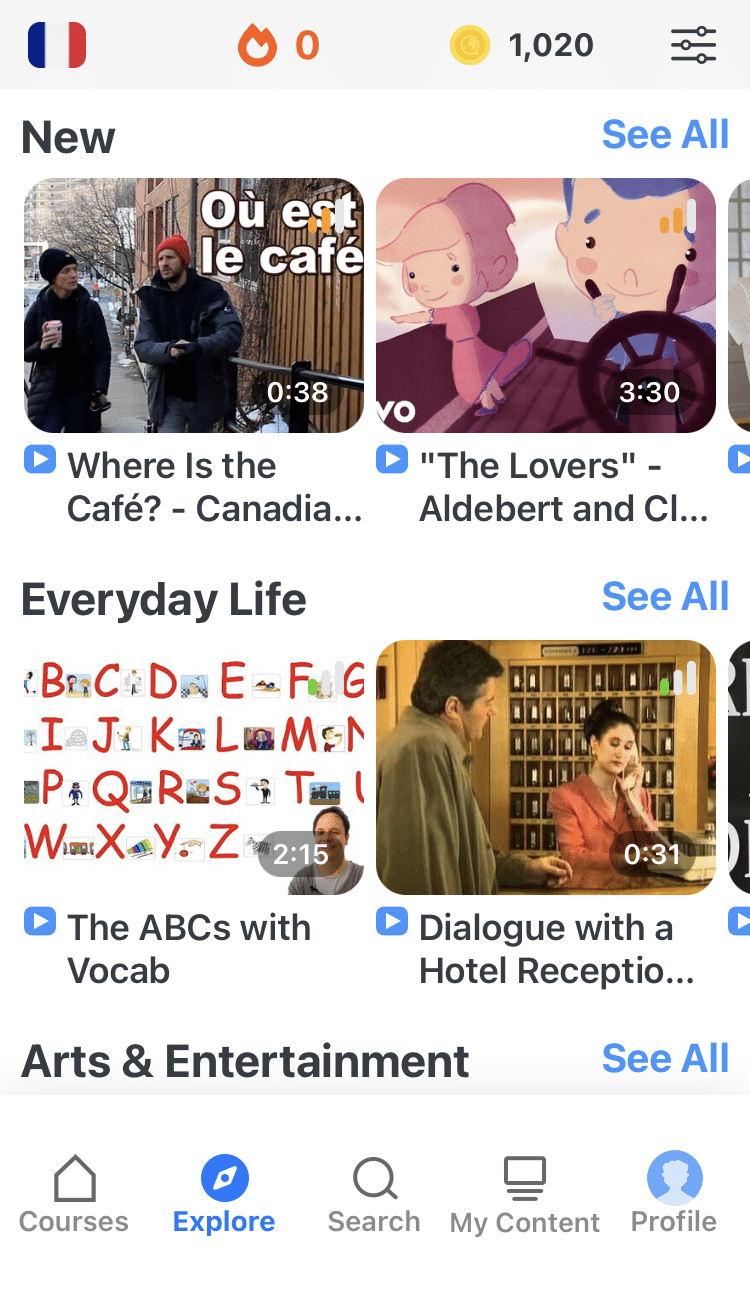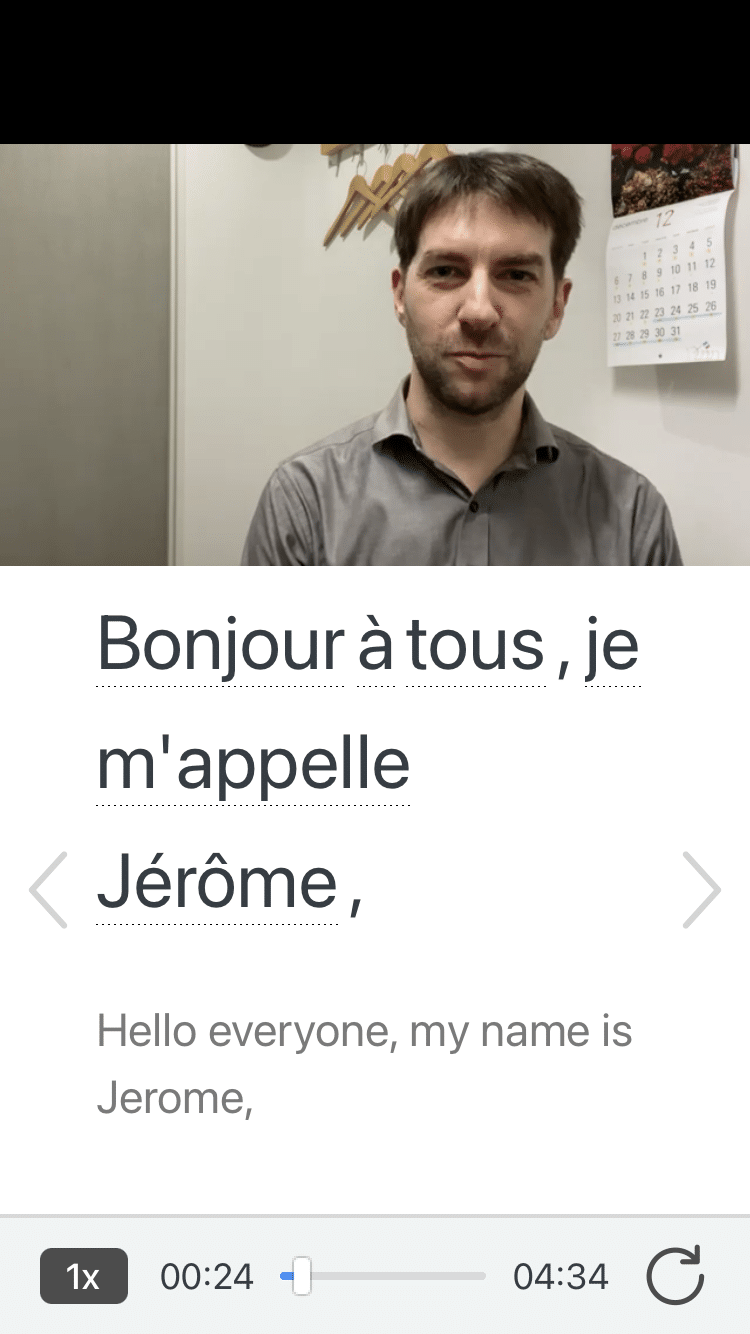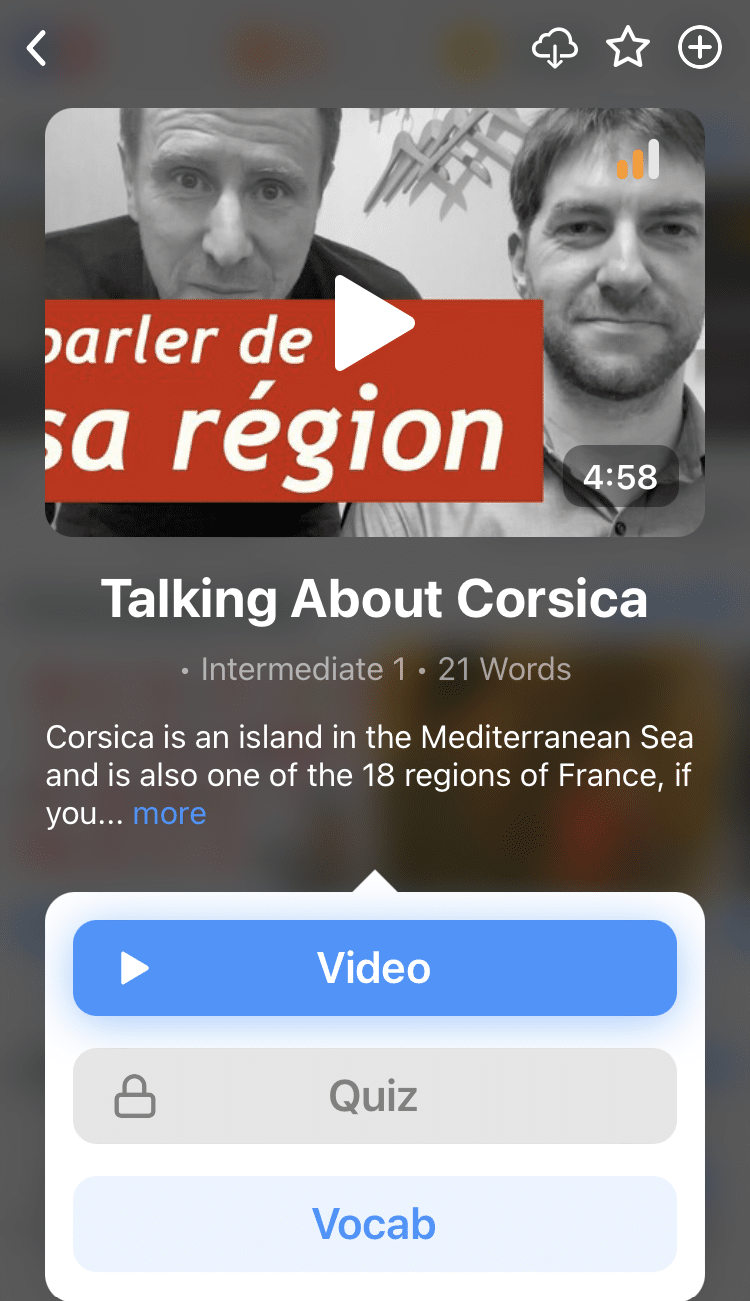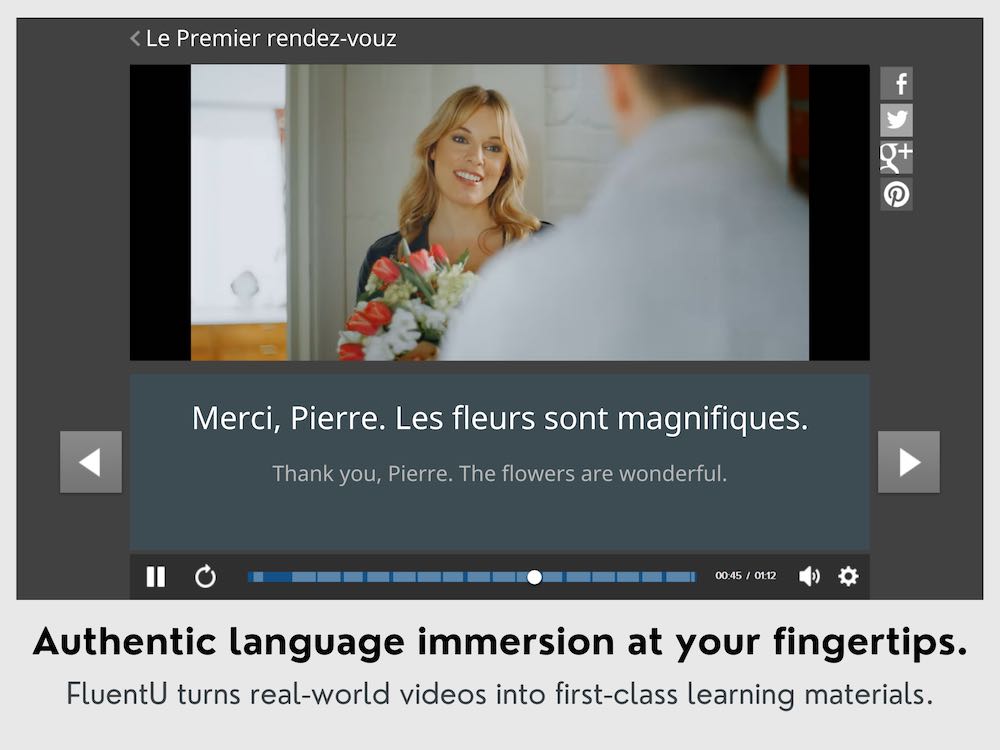
9 Ways to Say You’re Welcome in French
When you begin learning some French phrases for “you’re welcome,” they may seem a bit strange at first.
How exactly do French phrases that translate to “from nothing,” “I pray you for it” or “there is no what” amount to “you’re welcome?” More importantly, what’s the difference between these phrases?
Here, we’ll introduce you to the many options you have when saying “you’re welcome” in French, what they each mean and when you should use them.
Contents
- 1. The Most Popular: De rien
- 2. The Formal One: Je vous en prie
- 3. The Less Formal One: Je t’en prie
- 4. The Reassuring You’re Welcome: Pas de problème
- 5. The Casual One: Il n’y a pas de quoi
- 6. The Chill One: Pas de souci
- 7. The Southern French Option: Avec plaisir
- 8. The Swiss Choice: À votre service
- 9. The Canadian Option: Bienvenue
- So… Which Do I Use?
- And one more thing...
Download: This blog post is available as a convenient and portable PDF that you can take anywhere. Click here to get a copy. (Download)
If you prefer consuming video content, you can find more pronunciation and tips about these phrases with the video below on how to say “you’re welcome” in French:
1. The Most Popular: De rien
De rien is the first form of “you’re welcome” I learned in French class and, for a long time, it was the only one I knew. This isn’t surprising considering that de rien is the most common “you’re welcome” phrase used in France.
My mom never liked it though because it literally means “from nothing,” which could imply that what you did was inconsequential or undeserving of gratitude. In a sense, that’s true.
De rien is generally used as a response to basic courtesies or friendly favors, like holding the door open for someone, offering a compliment or frequenting a business. The phrase isn’t exactly self-deprecating, but technically it downplays the action.
We should be careful not to read too much into the word-for-word translation, though. Language is much more subtle than that, and literal translations rarely work.
In other words, although de rien literally means “from nothing,” you shouldn’t ban it from your vocabulary. Yes, small acts of kindness do matter, and de rien is commonly used and understood in much the same way that “you’re welcome” is in English.
Example:
A: Quelle belle robe ! (What a beautiful dress!)
B: Merci ! (Thank you!)
A: De rien. (You’re welcome.)
If de rien is so popular, why should you bother reading about the other phrases listed here?
While de rien is fitting for many situations, it’s considered informal and isn’t the best option to use in a professional context or when you need to make a good impression.
So, if you’re doing business in French or are meeting with someone important, it may be better to go with a different phrase.
2. The Formal One: Je vous en prie
Je vous en prie is the most formal, traditional way to say “you’re welcome” in French. This is the phrase to employ in a business setting or when you want to show someone extra respect.
Example:
A: Je vous remercie de m’avoir considéré pour ce poste. (Thank you for considering me for this position.)
B: Je vous en prie. (You’re welcome.)
Remember how I said that literal translations rarely work? Je vous en prie is an excellent example, as its literal translation is “I pray you for it.”
Je is the first person singular pronoun, “I.” Vous is the formal or plural second person pronoun, “you.” Since vous is being used as a direct object, it goes right after the subject and before the verb.
En is a pronoun that replaces de (of, for) and its object in certain sentences. Here, it refers to the action which sparked gratitude and amounts to “for it.” Finally, prie is a conjugated form of the verb prier (to pray).
So… how does that mean “you’re welcome?” It certainly seems like a strange, stuffy old phrase from a medieval court. Technically, it’s a way of asking permission to do whatever you did in the first place. In a sense, this phrase completes the conversational cycle.
It may sound like we’re overthinking this, but it could improve your understanding of the phrase. The cycle begins when a certain need is presented: Let’s say you’re on the métro (French subway system). The car is packed, and an older woman boards.
Next is the action, in this case offering the woman your seat. Then comes acceptance and gratitude: The woman sits and says merci beaucoup (thank you very much).
Finally, you respond with je vous en prie, which humbly refers to the action and makes the conversation come full circle.
Or, it could be interpreted as a hyper-polite way of requesting the honor of giving up your seat.
In any case, you don’t need to remember all of that unless you want esoteric knowledge you can bring up later to win a trivia game or impress people at a dinner party.
The important thing to know is that je vous en prie is the most formal, proper way to convey “you’re welcome” in French.
3. The Less Formal One: Je t’en prie
Does this phrase look familiar? Je t’en prie is essentially the same as je vous en prie. The formal you pronoun, vous, has simply been replaced with the informal tu.
The result is a semi-informal way of saying “you’re welcome.” It’s informal because you use it with people who you address as tu, but it’s also formal because it has the same construction and sense of permission as je vous en prie.
In other words, it’s more formal than de rien but less formal than je vous en prie.
So when exactly would you use it? Je t’en prie is a good option if you simply want to be extra polite or if your gesture was particularly generous, like giving someone an expensive or deeply meaningful present.
Example:
A: Merci mille fois pour le cadeau ! J’adore ce jeu. (Thank you very much for the present! I love this game.)
B: Je t’en prie. (You’re welcome.)
4. The Reassuring You’re Welcome: Pas de problème
Here’s one that’s easier to understand, one that actually can be taken literally! Pas de problème is simply and directly translated as “no problem.”
As in English, this phrase can be used to reassure your interlocutor that your kind gesture wasn’t an inconvenience to you.
Think about it: When someone goes out of their way to help you, you might worry that your need cost them their time, or you may even feel like you were a burden.
Pas de problème would encourage you not to stress over it. Likewise, you can say it to ease the mind of someone you’ve helped.
Example:
A: Merci de m’avoir attendu. Le train est arrivé en retard. (Thanks for waiting for me. The train arrived late.)
B: Pas de problème. (No problem/You’re welcome.)
5. The Casual One: Il n’y a pas de quoi
Unfortunately, this one isn’t so straightforward. Il n’y a pas de quoi literally means “there is no what,” which probably doesn’t tell you much about what it actually means.
The phrase derives from il y a (there is), the negative particle pas de (no, none) and the interrogative article quoi (what). In short, it’s best to think of it as “there is no reason [to thank me].”
In sense and function, it’s similar to de rien, as it could suggest that appreciation isn’t necessary. Il n’y a pas de quoi is also casual, so you’d probably reserve using it for those basic, everyday gestures and avoid saying it in a formal situation.
Example:
A: Merci pour la pizza. (Thanks for the pizza.)
B: Il n’y a pas de quoi. (You’re welcome.)
You can use it relatively interchangeably with de rien, but this one is harder to say (since it’s longer) and a bit less common.
Since il n’y a pas de quoi is a bit long, in practice, it’s often shortened to a quick y’a pas de quoi.
6. The Chill One: Pas de souci
This phrase literally translates to “No worries” and is used very similarly to Pas de problème.
This is an informal way to say “you’re welcome” but it sometimes means something more like “all right.” Pas de souci can also just be a way to let someone know that something isn’t a big deal.
Some of the more traditionally minded French language experts (like the Académie Française) believe the phrase is overused and could be replaced by oui (yes) in a lot of cases.
And some people find the phrase to be rude or even pompous—so while most French speakers you meet probably won’t find Pas de souci to be rude (it’s very commonly used), you might want to be careful about using it in formal situations.
Example:
A: Merci d’avoir retrouvé ma bague. (Thanks for finding my ring.)
B: Pas de souci. (No worries/You’re welcome.)
7. The Southern French Option: Avec plaisir
French isn’t just about the textbook Parisian French most people learn. The language is spoken around the world, and each region has its unique accent and expressions.
Next, we’ll be looking at a few “you’re welcome” phrases specific to different regions of the French-speaking world. For these phrases, the key factor in choosing which to use is not formality, as with the previous ones, but location.
Avec plaisir (with pleasure), for instance, is a common response used in southern France, especially in Toulouse, but it could sound awkward in other areas.
Fortunately, though, avec plaisir is straightforward, especially for English speakers, since it’s almost the same as “my pleasure.”
Pay attention, though, because mon plaisir, the direct translation of “my pleasure,” isn’t really used in French and would sound a bit strange.
But in southern France, avec plaisir is an enticing option to diversify your vocabulary and sound more like a local. Avec plaisir kindly conveys that you enjoyed what you did or were glad to help.
Example:
A: Merci pour la lettre que tu m’as envoyé. (Thanks for the letter you sent me.)
B: Avec plaisir. (With pleasure/you’re welcome.)
8. The Swiss Choice: À votre service
Now we’re headed to one of France’s neighbors, Switzerland. One of their local expressions is à votre service, which means “at your service.”
It might seem a bit chivalrous, but it’s a polite way of saying that you were just doing your duty.
Also, note that because this phrase includes the formal possessive pronoun votre, it’s appropriate to use with people you don’t know very well. This especially makes sense if you’re acting in an official capacity, such as waiting tables at a restaurant or working at a hotel.
Example:
A: Merci beaucoup ! Le dîner était excellent. (Thank you very much! The dinner was excellent.)
B: À votre service. (You’re welcome.)
Most likely, though, you’re looking to travel in Switzerland, not work in the Swiss hospitality industry. But now you’ll understand the expression if someone uses it to respond to your own “thank you.”
And, you can still employ it yourself if you want to be extra courteous or practice your Swiss French.
9. The Canadian Option: Bienvenue
Next, we’re off to the Canadian province of Québec, where a distinct form of French, québecois, is spoken. One of their regional phrases is bienvenue.
However, it’s not the bienvenue you’re used to. There’s a good chance one of your first French words was bienvenue, meaning “welcome” (as in “welcome to my home”).
While this is indeed a common and certainly helpful expression, in Québec, the exact same word is sometimes employed to communicate “you’re welcome.”
Example:
A: Merci pour le café. (Thanks for the coffee.)
B: Bienvenue. (You’re welcome.)
It may seem strange at first, but ironically, this is almost exactly what we say in English: “you’re welcome.”
Be careful, though; outside of Québec, the word is rarely used in this sense.
In fact, in other parts of the world, saying bienvenue in response to merci would seem about as out-of-place as it did to you when you started reading this section.
So… Which Do I Use?
We’ve certainly opened up your options for saying “you’re welcome.” Adding to your French repertoire is always a plus, but we understand that in the midst of a conversation, you probably don’t have time to run through a list of possible responses, weigh each one, consider the contextual factors and finally settle on the most appropriate choice.
When in doubt, just remember: je vous en prie for formal situations and de rien for informal ones. These two are widely used and aren’t unique to a particular region.
Still not sure? Formality in French culture can be difficult to interpret, but in general, too formal is better than too informal.
Je vous en prie may sound over-the-top in certain cases, but it’s better than potentially offending someone by being too familiar.
Practicing these social situations is essential. Luckily, tons of examples of informality and formality can be found in French media, so feel free to look up YouTube clips of talk shows, news segments and movies to see how native speakers navigate these situations.
FluentU takes authentic videos—like music videos, movie trailers, news and inspiring talks—and turns them into personalized language learning lessons.
You can try FluentU for free for 2 weeks. Check out the website or download the iOS app or Android app.
P.S. Click here to take advantage of our current sale! (Expires at the end of this month.)
I hope this article has expanded your French horizons.
If it did, let me just say, de rien.
Download: This blog post is available as a convenient and portable PDF that you can take anywhere. Click here to get a copy. (Download)
And one more thing...
If you like learning French on your own time and from the comfort of your smart device, then I'd be remiss to not tell you about FluentU.
FluentU has a wide variety of great content, like interviews, documentary excerpts and web series, as you can see here:

FluentU brings native French videos with reach. With interactive captions, you can tap on any word to see an image, definition and useful examples.

For example, if you tap on the word "crois," you'll see this:

Practice and reinforce all the vocabulary you've learned in a given video with learn mode. Swipe left or right to see more examples for the word you’re learning, and play the mini-games found in our dynamic flashcards, like "fill in the blank."

All throughout, FluentU tracks the vocabulary that you’re learning and uses this information to give you a totally personalized experience. It gives you extra practice with difficult words—and reminds you when it’s time to review what you’ve learned.
Start using the FluentU website on your computer or tablet or, better yet, download the FluentU app from the iTunes or Google Play store. Click here to take advantage of our current sale! (Expires at the end of this month.)



